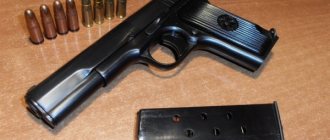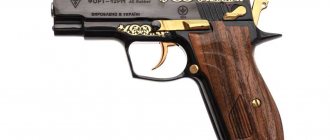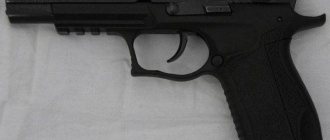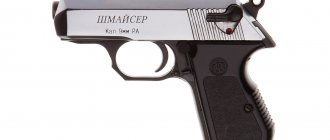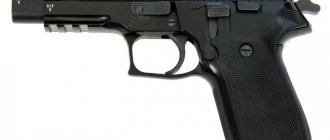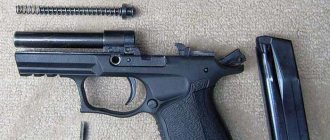At the beginning of the 90s of the last century, the question of replacing the weapons that were then in service with the Ministry of Internal Affairs arose in Ukraine. The Makarov, which the security forces used at that time, was physically and morally outdated, and therefore did not meet the requirements for weapons for personal carry by employees of the Ukrainian Ministry of Internal Affairs.
The Ukrainian designers were faced with the question: what should a new weapon be like so that it can meet modern requirements and technologies? Of course, the weapon had to be accurate, convenient, the accuracy of the fire was maximum, and the magazine had to hold more cartridges than in the Makarov, but at the same time the charges themselves had to be of the most common caliber - 9 mm RA. Moreover, this “good” was more than enough in Ukrainian military warehouses in those days.
Such a weapon was the Fort 12 injury weapon, developed in the city of Vinnitsa by a design bureau headed by Pyotr Zaitsev.
Traumatic pistol Fort-12T
Looking at the market of traumatic weapons in Ukraine, one cannot help but notice that more than half of all models of traumatic weapons are Fort traumatic pistols in a wide variety of designs and options.
Such a wide distribution of Fort traumatic pistols is primarily due to the high quality of these weapons, which accordingly creates a demand for these traumatic options. Therefore, it is not surprising that several models of Fort traumatic pistols have “leaked” onto the domestic market for self-defense equipment and not only in the form of derivatives such as Jorge or Groza. By the time the Fort-12T traumatic pistol appeared on the Russian market of traumatic weapons, it already had a competitor, made in complete analogy with itself, it was the Jorge traumatic pistol, which, in fact, was the Fort-12T only with a different name. In general, traumatic pistols differed only in their inscriptions and were even manufactured at the same factory. But they came to the domestic market in slightly different ways. If the parts of Jorge’s traumatic pistol were made at the Fort factory, and the weapons were assembled by the Klimovsky specialized cartridge plant, then the Fort-12T was made and assembled at the Fort factories, and the Moscow company Umarex-M imported ready-made pistols to Russia.
Despite their external similarity with the famous Jorge, the Fort-12T traumatic pistols did not gain the same popularity as their counterpart assembled at KSPP, there were several reasons for this. Firstly, many consumers expressed serious concerns about cases of service repairs; it was understandable that traumatic pistols would be repaired, but in the case of Jorge everything was simple, the repairs took place in Russia, but the Fort-12T would need transported to Ukraine, which would naturally affect the service time. To be fair, it is worth noting that the “repair” of the Fort-12T was even faster than that of Jorge, since Umarex-M simply replaced pistols and did not repair them. The second “stone in the garden” of the Fort-12T was that in August 2007, more advanced barrels for Jorge’s pistols had already appeared, by the way, and the first version of the barrels was also different from the Fort-12T. Well, since the barrel of a traumatic gun is actually the main part by which the choice of weapon is made, fans of traumatic pistols paid special attention to this. Already after the first tests, it was noted that the barrels of the Fort-12T traumatic pistol were significantly weaker than the barrels of Jorge’s traumatic pistol, which in turn led to swelling of the barrel with the ammunition that Jorge worked with without problems, accordingly, this traumatic pistol was immediately deleted from the list of weapons worth attention, especially since initially the price of the Fort-12T traumatic pistol was even higher than Jorge’s price, then it dropped, but there was no significant reduction in the price of the weapon.
It must be said that a weak barrel of a weapon is not the rule for this model of a traumatic gun; there were also those pistols that could withstand the use of the most powerful ammunition, but since no one wanted to take risks when purchasing, this model of a traumatic gun was inferior to Jorge’s traumatic pistol. In addition, even if we discard the possibility of inflating the barrel in this traumatic gun model, the pistol will still be less effective, albeit not much more than the Jorge with subsequent versions of the barrels, due to the fact that the “teeth” inside the barrel of the Fort-12T traumatic pistol were far from the most ideal design. So the main disadvantage is that if the bullet was made of soft rubber, then if the permissible speed of its movement along the barrel is exceeded, it will simply burst on the “teeth”. In principle, the same problem was encountered in the Jorge traumatic pistol with the first version of the barrel, but by the beginning of mass sales of the Fort-12T traumatic pistol, the barrels in Jorge had already been replaced with more advanced ones. In everything except the barrel of the weapon, the Fort-12T traumatic pistol is quite a passable device, and if compared with many other models in terms of the quality of processing of weapon parts, then the Fort-12T is certainly among the leaders. This is not surprising, since no one argues that the Groza and Jorge traumatic pistols are among the best in terms of production quality, and since they are assembled from exactly the same parts as the Fort-12T, the conclusion suggests itself yourself. What is also noteworthy about this pistol model is that, thanks to the wide distribution of the Jorge traumatic pistol, it is very easy for the Fort-12T to choose a holster that will be suitable specifically for it, and therefore will be comfortable and will not create inconvenience when carrying the pistol every day.
Pistol "Fort" - to replace the "Makarov"
At the end of the 90s, the first locally developed personal weapons were developed, launched into mass production and adopted in Ukraine. It “inherited” the name from the developer – the state scientific and production association “Fort”.
For more than 20 years, these Ukrainian pistols - from the basic model "12" to the latest version "17" and the traumatic "Fort-12RM" - have been mass produced and are in service with some countries. Traumatic weapons of this design have even become widespread in Russia. The plant in Klimovsk produced non-lethal weapons under a Ukrainian license for some time.
Conclusion
The Fort-12RM turned out to be an excellent traumatic weapon, which inherited the best qualities and characteristics from its combat ancestor. It can be safely used as the main weapon for reliable civilian self-defense. It has excellent power, good magazine capacity and high reliability, which provides a large supply of working life.
It is worth noting that Fort-12 is suitable not only for good self-defense, but it can also be used for recreational or sports shooting. However, we must not forget that, like any other traumatic weapon, this weapon requires regular cleaning of all its parts, especially those that bear the greatest load when firing.
History of creation
After 1991, the army and police of independent Ukraine were left with a single service and combat pistol - the PM. This weapon has not satisfied users for a long time, but before the collapse of the USSR, a replacement was never found.
Even during the existence of the Soviet Union, a special department of the Internal Affairs Directorate was located in Vinnitsa, producing “special equipment”. At the beginning of 1991, it was reorganized into the Fort research and production association.
In 1994, an instrument-making plant was placed at the disposal of this NGO.
From this moment we can count down the creation of the first Ukrainian combat pistol “Fort”. To assist in development, contacts were established with the Czech company CZ. Equipment for the production of weapons was received from the Czech Republic, and serial production began in 1998.
Device Description
The design of Fort brand pistols is quite typical for low-power personal weapons. The notorious low power of the 9x18 mm caliber cartridge made it possible to use a free-bolt design in automatic operation, which locks the barrel with its own weight.
The trigger mechanism is double action. It allows you to open fire, both by pre-cocking the hammer, and without cocking, by self-cocking. There is a safety lever on the left side of the body; it blocks the bolt, trigger and trigger (even if the pistol is cocked).
The magazine is made of metal and contains 12 rounds, arranged in 2 rows. To speed up and facilitate reloading there is a slide stop, which is activated by the magazine feeder. The sight is open, consisting of a front sight and rear sight. To make aiming easier in the dark, the sight is equipped with luminous markings. Modifications intended for sport shooting were equipped with an adjustable sight. "Forts" can also be equipped with a laser target designator and a tactical flashlight.
In general, the trigger mechanism of the “Fort” is similar to the trigger mechanism of the Czech pistol CZ 82/83.
The design of the trigger guard was borrowed without changes from another model - CZ 75. It should also be noted that until 2002, when Vinnitsa had its own barrel production, this unit was supplied from the Czech Republic.
Fort-12R design
The gun's automation is built according to the blowback recoil pattern familiar to all trauma lovers. The gun barrel is not fastened to the bolt, and the channel is locked during firing by the return spring and under the action of the mass of the bolt.
The automation operation diagram is as follows:
- When the firing process begins, the bolt is pushed through the bottom of the cartridge case with the help of powder gases, pushing it back, and the bullet, having left the case body, begins to move along the barrel;
- When the reverse movement begins, the shutter is pushed by the disconnector, as a result of which the trigger rod and sear are disconnected. The latter is pressed against the trigger by the combat protrusion;
- The trigger, due to the pressure on it from the bolt, engages the sear lug, and is then fixed in the cocked position;
- Continuing to move backward, the bolt, through the extractor, catches the spent cartridge case and, hitting the ejector, throws it through the bolt window;
- After this, the reverse movement of the bolt begins, which is ensured by the return spring. At this stage, the bolt catches a new cartridge and sends it into the chamber, after which the barrel bore is locked by the bolt mirror;
- Once in the extreme forward position, the bolt releases the disconnector, as a result of which all the load is removed from the trigger. After this, the sear and trigger rod are connected.
Fort-12RM, which is very convenient to carry in a holster, is equipped with a double-action trigger mechanism with an open hammer. This makes it possible to fire the first shot with the hammer cocked, which increases shooting accuracy. Subsequent shots are only possible with the hammer cocked. In general, the trigger is made based on the design of the popular Czech-made CZ-75 gun, so such a mechanism in a Ukrainian pistol is of excellent quality.
For the safety of the shooter, this gun uses a flag-type safety, the lever of which is located on the left side of the rear part of the bolt housing. Such a system protects the gun owner from an accidental shot in a trouser pocket or in a holster, as well as when falling to the ground.
Fort-12RM is a convenient weapon. Due to its size and shape, it is convenient to hold not only in one hand, but also in two, which improves the accuracy and accuracy of shooting. The main convenient element that makes shooting as comfortable as possible is the front part of the bracket with external corrugation. The handle was made at the factory to fit the average size of a person’s palm. This allows the Fort-12 traumatic pistol to be used by both people with small and large hands. During shooting, the recoil is practically not felt.
The barrel bore has high strength due to the technology used to manufacture it. Firstly, it is created using a unique barrel steel, which was developed specifically for the Fort-12RM. In addition, the channel has a hexagonal groove consisting of 6 grooves. High quality is confirmed by effective shooting, the performance of which is much higher than that of the Makarov.
- 9 mm PA cartridges are used;
- The length of the pistol is 180 millimeters;
- The barrel length is 95 millimeters;
- The height of the weapon is 131 millimeters;
- The width of the weapon is 32 millimeters;
- The weight of the unloaded pistol is 830 grams;
- The magazine capacity is 15 rounds.
Modifications and operation
In addition to the basic modification of the Fort-12, a large number of different options have appeared. "Fort-12B" is a silent pistol for special forces, equipped with an elongated barrel adapted for installing a silencer, and the silencer itself.
The award-winning “Fort-12N” has a body made of alloy steel, handle cheeks made of precious wood, decorated with carvings, silvering and gilding. For some time, the sports “Falcon” was produced, intended for practical shooting competitions. It was equipped with an adjustable sight and a recoil compensator.
Accessories [edit]
- LT-6
(
LT-6
) - machine gun canopy mounted under the barrel. [21] - LT-6A
(
LT-6A
) - machine gun canopy with the ability to be installed under the barrel. - Fort-4
(
Fort-4
) - removable silencer for Fort-12B [21] - standard holster
for uniformed security personnel [22] - tactical holster
for riot police rapid response units (Berkut)
Ukrainian traumatic pistol Fort 12T, converted from a combat one
In Russia, several generations of short-barreled weapons have changed. Their replacement was subject to the need to respond to historical challenges. The first mass-produced repeating pistol was the Smith-Wesson revolver, which was adopted simultaneously with the Berdan rifle. Its caliber was four lines, which made it possible to make revolver barrels from defective rifle barrels.
The next weapon was the Nagan revolver. It was put into service along with a three-line rifle. Similarly, the caliber was chosen to use waste from mass rifle production.
In the thirties of the twentieth century, the use of automatic pistols became relevant. The legendary TT appeared. During its operation, the circumstance became clear that, having a high firing range and penetrating ability, the pistol did not have the necessary stopping effect. Often, a mortally wounded enemy managed to reach the shooter before death and hit him with a knife, bayonet or sapper shovel.
It was the turn of the Makarov pistol. Its 9-mm bullet, when hitting a person, almost always rendered him completely incapacitated. However, since the beginning of the eighties of the twentieth century, body armor has become increasingly widespread. A Makarov pistol usually cannot penetrate body armor. A need arose for a pistol that, while maintaining the high stopping power of a 9 mm bullet, would acquire penetration power sufficient to defeat body armor of the third class of protection.
In service
- Ukraine Ukraine - “Fort-12” in December 1998 was adopted by the police and internal troops of Ukraine, entered service with the employees of group “K” of the Central Security Service “A” of the Security Service of Ukraine, and special-purpose police units “Berkut”. In November 2000, before being sent to the Ukrainian UN peacekeeping contingent on the territory of Yugoslavia, employees of the special canine unit of the Ministry of Internal Affairs of Ukraine (35 people) were armed with Fort-12 pistols. Enters service with the state security service. As of mid-2004, 12% of the personnel of the Ministry of Internal Affairs of Ukraine were armed with Fort pistols. As of the end of August 2009, the issue of mass rearmament of personnel of the Ukrainian Armed Forces from PM pistols to Fort-12 pistols was not considered. As of November 2012, a number of Fort-12 pistols were in service with employees of the physical protection departments of the tax police of the State Tax Service of Ukraine. As of July 2014, a number of pistols were in service with the special unit “Griffin” of the judicial police of the Ministry of Internal Affairs of Ukraine
- Kazakhstan Kazakhstan - in February 1999, the Minister of Internal Affairs of Ukraine, General of the Internal Service Yu. F. Kravchenko announced that a small batch of Fort-12 pistols was sent to Kazakhstan, for the Ministry of Internal Affairs of the Republic of Kazakhstan
- Uzbekistan Uzbekistan - in October 2000, a contract was signed for the supply of a batch of pistols to Uzbekistan
- Russia Russia - a number of pistols became available in March 2014. The Simferopol Berkut detachment received Fort-12 pistols in October 1999. After the annexation of Crimea to Russia, the Crimean Berkut continued to serve as a unit of the Ministry of Internal Affairs of the Russian Federation
The appearance of Fort 12
Similar models of pistols appeared in a number of countries. The Fort 12 pistol was developed in Ukraine. In addition to increased muzzle energy, the pistol has a high magazine capacity, 12 rounds, a magazine release button next to the safety bracket, which allows you to reload the weapon faster.
The pistol began to be developed in 1995 together with Czech gunsmiths. The first batches of weapons were equipped with foreign-made barrels. It was possible to establish a completely in-house production by 2002.
The pistol is made entirely of weapons-grade steel, which makes it very heavy and durable. Based on the combat pistol, two traumatic versions were created. They differ from each other in their trunks. One model has a smooth barrel, while the other has serrations that prevent the inelastic bullet from being fired.
The first to be created was a smooth-bore traumatic pistol as a service weapon. He realized the idea of creating a survival pistol. The smooth barrel allows the use of high-power cartridges with over-caliber rubber bullets. You can shoot round lead bullets and shot. Trauma can be carried by the crews of ships or airplanes and helicopters. At this time, the Ukrainian military actively participated in peacekeeping operations around the world, and this was relevant.
Disassembly and assembly
Fort-12 on the slide stop
Fort 12 incomplete disassembly
Fort-12R, magazine removed
To perform partial disassembly of the Fort-12 pistol, you must:
- Make sure the weapon is unloaded. To do this, you need to remove the magazine, pull the bolt back and inspect the chamber.
- Use a magazine or cleaning rod to press the bolt stop axis on the right side.
- Separate the bolt stop by pulling it from the left side.
- Separate the shutter. To do this, move the bolt to its rearmost position, lift its rear end and move it forward, removing it from the barrel.
- Pull out the return spring and its guide.
The pistol is reassembled in the reverse order. After assembly it is necessary to inspect:
- Pull the trigger, turn on the safety. The bolt, hammer and trigger must be locked.
- Turn off the safety, cock the hammer, turn on the safety. The bolt, hammer and trigger must be locked.
- Turn off the fuse and perform an idle descent.
- Insert the magazine, check the reliability of its fixation.
Traumatic version of the pistol
A version of the traumatic pistol with teeth in the barrel was developed for civilian use. Initially, the pistol was made as a gas pistol, and then for export to Russia it was turned into a gas pistol suitable for firing traumatic ammunition.
All parts of the Fort 12T are identical to those of the combat pistol with the exception of the barrel.
Like all traumatic pistols that were created in the early 2000s, these pistols experienced numerous firing delays. The main reason for the failure of automatic reloading until 2011 was solved by creating a powerful traumatic cartridge. Muzzle energy reached 240-250 J.
During these years there was a legal incident. Barrelless traumatic pistols: Osa, Kord, Ratnik had a limitation on the maximum shot energy, but gas traumatic pistols did not have such a limitation. This made it possible to develop ammunition for them with muzzle energy comparable to live ammunition.
Comparative tests of the old cartridge and the new cartridge with an energy of 80 J show the following results. The new cartridge penetrates one sheet of standard plywood, makes a dent in the second sheet and ricochets. When the 2011 model cartridge was fired, four standard sheets of plywood were pierced, and the bullet only ricocheted off the fifth sheet. After the introduction of restrictions on muzzle energy in 2011, the pistol began to be equipped with a second weakened spring for firing weak cartridges.
Issue overview
Problems arise primarily due to the fact that the pistol is traumatic. All these pistols, just like the traumatic Stechkin or Makarov, were developed for a live cartridge. The traumatic cartridge differs in size.
It is known that weapons are made for ammunition, and not vice versa. If you compare traumatic and combat 9 mm cartridges, you can immediately see that they differ in size. A traumatic cartridge is half a millimeter thinner than a live cartridge.
All parts of a combat and traumatic pistol are the same with the exception of the barrel. There is an opinion that parts of traumatic pistols are not hardened, but this is not true.
The length of the traumatic cartridge is 4 mm longer than that of the live cartridge. The live cartridge has a rounded bullet that fits easily into the chamber. In a traumatic cartridge, the bullet is recessed and it enters the chamber with a blunt cut of the cartridge case. It is thrown upward and this causes sticking.
The next problem is the weak pinning of the primer, which leads to numerous misfires. This is due to the fact that the striker is not long enough. Craftsmen grind a new striker from hardened steel on milling machines.
The next problem is that the cartridge sticks into the upper part of the chamber and does not fire all the way through. To do this, you have to tighten the jaws of the magazine. Traumatic cartridges are narrower than combat cartridges, and the magazine used is standard. As a result, the cartridge does not sit tightly in the clip. The hardening of the jaws must be released and then pressed to the required size.
Due to the fact that the traumatic cartridge is longer than the combat cartridge, the cartridges often get stuck in the ejector window. It is necessary to bore the window 4 mm in length with a file.
Operating countries
- Ukraine - a number of Fort-9 pistols were received by the Ministry of Internal Affairs of Ukraine; in December 2022, several more pistols were ordered for railway security; traumatic Fort-9R, Fort-10R and Fort-10T are allowed for use by private employees security structures and as a civilian self-defense weapon
- Kazakhstan - after the purchase of traumatic weapons was authorized on January 1, 2008, a certain number of traumatic pistols “Fort-9T” and “Fort-10T” were sold in the country. On April 2, 2014, the Parliament of Kazakhstan established a ban on the possession and use of traumatic weapons by civilians. On October 29, 2014, a decision was made to buy back previously sold traumatic weapons from the owners, and on September 4, 2015, the traumatic pistols “Fort-9T” and “Fort-10T” were added to the list of models of traumatic weapons prohibited for circulation and subject to surrender. However, they are still permitted as service weapons for private security agencies.
Characteristics
The list of performance characteristics of the Fort 12T injury is as follows:
- The pistol has a length of 180 mm with a barrel length of 95 mm, a width of 95 mm and a height of 131 mm.
- The effective shot range is from 5 to 7 meters.
- Clip capacity 12 rounds.
- The speed of practical shooting reaches 40 rounds per minute, like a Kalashnikov assault rifle in single-fire mode.
- The weight of a loaded pistol is 900 grams, and the weight of an empty pistol is 830 grams.
- Caliber 9 mm R.A., muzzle velocity is 320 meters per second.
- Double action trigger.
Feedback from shooters said that the weapon was too heavy for everyday carry. A constructive solution was found. In 2007, deliveries to Russia of a plastic version of the pistol called Fort 17T began. Structurally, this version was no different from the iron version of the weapon, but had significantly less weight. The weight of the pistol without cartridges was 680 grams.
Notes
- ↑ V.F. Glushchenko, L.B. Beznosyuk, A.O. Kolokolov, A.V. Movchan, Yu.V. Melnik, V.I. Kuzmin. Vogneva preparation. Chief assistant. Kiev, 1998
- Igor Yatsenko. A piece of iron on the belly // “Soldier of Fortune”, No. 6, 1996. pp. 40-42
- ↑
- Fort-12 // magazine “Weapons and Hunting”, No. 2, 2005
- ↑
- Ph.D. tech. n. O. S. Marchenko, S. G. Osmak, S. I. Shumak. Current aspects of the need to equip special and tactical lighters // magazine “Suchasna special equipment”, No. 4 (27), 2011. page 5-12
- V. V. Shcherbak, O. O. Tolmachov, O. V. Kundius, A. A. Abdurasulov. Possibility of establishing a model of a fire outbreak when shooting with pistols “Fort” caliber 9x18 mm // “Criminal News”, No. 2 (22), 2014. pp. 128-133
- The “Fort” enterprise of the Ministry of Internal Affairs of Ukraine is ten years old // “Arms and Hunting” magazine, No. 1, 2005
- Decree of the President of Ukraine No. 341 of April 29, 1995 “On the obliteration of the signs of the President of Ukraine “Named fire protection”
- (unavailable link). Retrieved September 12, 2010.
- ↑
- (unavailable link). Retrieved September 13, 2010.
- Certificate of Conformity No. ROSS.RU.МЖ03.В02248 Fire pistol of limited destruction model Jorge chambered for 9 mm PA caliber
- (unavailable link). Retrieved September 13, 2010.
- (unavailable link). Retrieved March 9, 2012.
- Resolution of the Cabinet of Ministers of Ukraine No. 1056-r dated December 21, 1998
- Order of the Ministry of Internal Affairs of Ukraine “On the organization of civil security service activities of the State Security Service under the Ministry of Internal Affairs of Ukraine” No. 1430 dated November 25, 2003
- “ There is no mention of the massive re-establishment of the Ukrainian military from the Makarov to the Fort-12.
»Andriy Baevsky. “Vepr” at “Kolchuzi” // magazine “Tizhden”, No. 35 (96) dated 08/28/2009
Current situation
Until 2011, Ukrainian trauma products were sold in Russia. After the import of imported traumatic weapons was banned, production was launched at domestic production facilities from Ukrainian components. The pistol was named Fort 12P.
In 2014, Ukraine banned the export of weapons components to Russia. Fort 12T parts were also banned. Pistol production was curtailed. Now you can only buy this pistol second hand. The price is approximately 40-50 thousand rubles.
Notes
- ↑
- ↑
- Fort-9R // V. N. Shunkov. Traumatic weapon. Complete encyclopedia. M., AST, 2014. pp.107-109
- ↑ Decree of the Government of the Republic of Kazakhstan No. 741 of September 4, 2015
- “ The subject of security activities has the right: to ensure security activities, add, save and use, in accordance with the procedure established by law, special features, the transfer of which is designated by the Cabinet of Ministers of Ukraine
“Law Ukraine No. 4616-VI dated 22 February 2012 “About security activities” - Resolution of the Cabinet of Ministers of Ukraine No. 97 dated February 11, 2013. “About the confirmation of the transfer of special services, the preparation, preservation and use of which are affected by the subjects of security activity”
- Decree of the Government of the Republic of Kazakhstan No. 1145 dated October 29, 2014 “On approval of the Rules for the voluntary surrender of firearms without barrels and gas weapons with the possibility of firing traumatic cartridges by individuals who have the appropriate permission from the internal affairs bodies to store and carry weapons, as well as the transfer of technically serviceable and suitable for further use, voluntarily surrendered barrelless and gas weapons with the ability to fire traumatic cartridges to law enforcement agencies"
- Law of the Republic of Kazakhstan No. 85-II of October 19, 2000 “On Security Activities”

